Arts
Thinking Outside The Pani Puri

Brash young desi entrepreneurs flavor the American dining scene.
|
Vodka Pani Puri! Yes, this unlikely pairing has debuted in New York, symbolic of the new India being introduced to the American public. Forget Kiplingesque elephants, huge ornate wooden doors and bronze murals that have represented generic Indian décor in the hospitality industry until now. Dancing apsaras, many, many sitars and kama sutra touches have been the shorthand for an American stereotype of India. Today’s America is being curried by contemporary India – edgy, idiosyncratic and hip.
A new breed of hybrid entrepreneurs, many born in this country but still connected to India by invisible bonds, are setting their mark on the entertainment and dining-out scene. Some are reinterpreting India for the mainstream while others are exploring and invading the mainstream scene itself, from Atlanta to Arkansas to Texas – be it with Italian or Mediterranean cuisine, franchising popular dining concepts and sometimes creating their own, bringing their financial smarts and technical savvy to new ventures. Hemant Phul of New York is one such entrepreneur. He came to the United States as a teen with his parents, but visited India frequently and later married a woman from Bombay. “My wife Bhavna likes to party and we found out that there is a lack of decent places for Indians to party,” he says. “This whole party scene, which was in Bombay, was missing for a lot of the Indians over here.” “What we were trying to do was replicate Bombay nightlife in New York,” he recalls. “I really partied hard in Bombay. Everyone living there, at that age, wants to go out and party.”
On opening night, New York’s Bombay crowd turned out in full force. He says: “They party hard – and even in the blizzard we had a full house till 4 a.m. That’s the Bombay crowd! There’s 12 or 14 inches of snow outside – and they’re out partying.” Indian Americans, partying and in type of lounge? Phul says, “I think so. Everything Indian here is so kitsch. It is so India in your face. You open up an Indian restaurant – there are thals on the wall, there are palatial doors or ornate objects everywhere. You know, that’s not India. “The real Bombay scene is not like that; it’s very different. The perception of India should change in the minds of the westerners. We can be hip and cool also. The Americans are getting quite sophisticated. It doesn’t have to be snake charmers all the time.” While Earth NYC is a place to gather, a watering hole, it also offers Bombay-centric snacks. “Indian food has become a destination thing where you might try it once a month but not on an everyday basis. That’s not what people do in Bombay. There are light foods available so I’ve brought in the street foods of Bombay. That’s what I’m serving till 4 in the morning, whether it’s vada pao, masala pao, whether it’s frankies, chicken lollipops, Manchurian – anything you can imagine on the streets of Bombay. If it’s not on the streets, it won’t be on the menu.”
How about Vodka Pani Puri? Now that’s not served on the streets of Bombay, is it? Not losing his cool, Phul retorts, “Vodka isn’t – pani puri is. That’s our twist to it! A lot of people ask me so what Indian cocktails are you making. I tell them there are no Indian cocktails. We don’t put rose water in our martinis, we don’t put mangoes in our martinis. A martini is a martini is a martini, no matter where you go!” As a teenager, Phul’s first job was packing meat in New York’s meat packing district, after which he worked in Indian restaurants as busboy, waiter and then manager. So he’s soiled his hands? “Yes, absolutely. I’ve done dishes, I’ve done all that good stuff.” Although he went into IT and worked as the chief technology officer in advertising, the restaurant business was always on his mind. He says, “Once you know it you always yearn to go back because you know exactly what’s involved and there’s a lot of energy.” While Phul’s NYC Earth is the new kid on the block, young Indian Americans have been trying to bring the India they know to the cities they now inhabit. A few years back Payal Saha introduced the well loved street food, kati rolls, to Manhattan. The Kati Roll Co. is small, crowded and the waiting line stretches down to the sidewalk. Yet, with its orange exposed brick walls, Bollywood film posters and friends clustered around copper tables, it’s a happy, energetic place. After all, this is where you get a taste of a unique Indian street food right in the middle of New York. Situated in the frenetic West Village, the tiny spot is surrounded by countless other eateries with idiosyncratic names and food offerings. There is non-stop traffic on this street and the people who head up the stairs to this little restaurant come for its single item – kati rolls, succulent soft parathas, stuffed with unda (egg), chicken tikka, beef tikka, achari paneer or aloo masala.
Saha’s inspiration came from eating kati rolls during her childhood in Calcutta, where they are the most celebrated street food. The Kati Roll Company is doing so well that Saha is opening a second one in the diamond district. This year she’s also ventured into fine dining with Babu, a restaurant devoted completely to Calcutta food . “I don’t even have one thing on the menu which is not from Calcutta. It’s a very mixed menu to hreflect the city’s multicultural makeup,” she says. “Thus you have traditional Bangla food, Indian Chinese (the country’s oldest Chinatown is in Calcutta) – there’s also club food or continental food – known as Anglo-Indian food because of the British influence. Then there are also dishes particular to Calcutta’s Muslim population, such as a biryani with potatoes, and chicken Rezala, which has a yogurt base.” If you walk into this new restaurant you’ll be hard pressed to say it’s Indian. The décor is simple with some colonial influences, but nothing overtly Indian about it. Her frequent visits to Calcutta have kept her on top of the dining habits in her hometown and people’s changing lifestyles: “There’s lots of changes domestically. Earlier there were very few restaurants for Bangla food, but now people are eating out more and there are at least four good restaurants all serving the traditional dishes.” Most of her clients are drawn from the mainstream and Saha is trying some innovative marketing. For the past few weeks she’s listed no prices on the menu and patrons are invited to pay whatever they think the meal is worth. She introduced the concept so diners would not have to pay for the birth pangs or staff errors, but surprisingly, most people have been paying about what she thinks would have been her real price.
Bringing the home cuisine to America but from a new perspective has also been the motivation of Sunitha Ramaiah’s Bombay Talkie. Ramaiah, a lawyer turned restaurateur, admits that she had a vision of a modern take on an Indian teashop for a very, very long time and what made her choose the present time was her involvement in the venture capital industry. She recalls a report that American and international venture capital companies abroad were investing in companies in India so that they could create franchises all over the world. “So my thinking was, instead of getting a franchise from India, why not create my own franchise here?” says Ramaiah. “We do not have prepackaged goods for standardized recipes, so I thought why not have fresh, healthy foods and create my own business?” In its hip New York incarnation, Bombay Talkie is more of a teahouse than a tea-stall, and it is located in a two-story 18th century building in Chelsea, the happening downtown area with galleries, nightclubs and stylish shopping. Ramaiah decided to keep the design clean and starkly modern, hiring noted architect Thomas Juul-Hansen, who has designed restaurants like 66 and all of David Yurman’s fashionable retail stores. She wanted to invoke the spirit of the Indian dhaba or tea-stall and commissioned J.P. Krishna, India’s leading billboard artist, to paint six huge canvases inspired by Bollywood posters, such as Zeenat Aman in Satyam, Shivam, Sundaram and Rekha in Umrao Jaan. Ramaiah got the pros in the business involved: Jehangir Mehta was consulting chef and Didier Virot of Aix restaurant created the wine list. Executive chef Subu Mukherjee and executive sous chef, Gabriel D’Costa offer a mix of street foods, roadside offerings and curbside treats. The menu is a blend of simple, yet eclectic authentic Indian street foods as well as soups and salads and brunch dishes that are India-inspired. In the street bites, there are dosas, papdi chat, kathi rolls and that all time rest stop favorite, Kolivada Macchi, crispy red snapper with shoestring potatoes. You can also find teas, sandwiches and light snacks in a section titled The Return of the Raj.
The dinner menu has roadside favorites like Chicken Chettinad, (Sauteed chicken in red chilies and cardamom), Chicken Dhaniwal Korma (Ginger, poppy and melon seed chicken in a cilantro cream sauce), Nargisi Kofta (Scotch eggs enveloped in lamb with a rose water cashew sauce) and Nilgiri Coconut Kebabs (Lamb meatballs in a South Indian sauce of coconut and mustard seeds.) Tea is understandably the raison d’etre for a tea shop and Ramaiah has brought in the flavors of India – Nilgiri tea, Darjeeling tea and Assam green tea, as well as South Indian Filter Kofi and Cardamom Coffee. Desserts are definitely very New York with a touch of India, and include Mariebelle Cardamom Ganache – dark chocolate terrine infused with a pot of dark chocolate sauce and garnished with pistachio. Now how many dhabas would serve you that? There are also some fun drinks which you won’t find in a tea-stall in Ooty – cocktails named after popular Bollywood movies! So you could try Ankur – The Seedling – fresh pomegranate seeds and juice, premium tequila, Rose’s lime cordial and Cointreau. And if you’re suffering from unrequited love, try Umrao Jaan, composed of Bombay Gin, limejuice and saffron syrup – guaranteed to drown out your sorrows. An eclectic mix of cultures, Bombay Talkie doesn’t hit you over the head with carved elephants and ornate doors. While black and white Hindi film classics from the 50’s and 60’s play on the large flat TV, global music has been incorporated into the tracks by Grammy award winning producer Andres Levin of Fun Machine for ambiance. The young servers at the 65-seat restaurant are also quite international, dressed in hip tunics and pants designed by Sorelle Firenze. When it came to designing the menus, Ramaiah turned to another very New York influence, Vogue design director Anna Penford, who also designed the logo for Bombay Talkie. The end result is very much a blend of Ramaiah’s childhood in Ooty, her growing up in this country and her American education. She says, “There’s a different kind of energy. It’s not as if you’re taking India and transplanting it here. It’s kind of translated for the people here. I guess that’s partly because we’ve spent so much of our lives in America that it’s sort of natural because we grew up on two different continents and two different countries.” Ramaiah has kept her prices down. She says, “I worked in a law firm. I had many friends who worked in banking and other professions. And nobody at the end of the day wanted to go home and cook. So we went out and we ate out all the time. The problem was that nobody wanted to pay like $50 per person every day on a meal.” She said she wanted to create a space where people would come over and over again because they liked the food and it was affordable: “It suits the American market, because people do love to eat out in New York, especially young people, and why should they have to pay a fortune to do so?” Her goal is to make Bombay Talkie a viable franchise. She says: “My job has always been to grow this business, to get into the pre-packaged market, all sorts of things. Whether I succeed or not, that’s up to God, but these are my plans.”
If Ramaiah gave up the world of law for that of chai, Nandini Mukherjee, a Calcuttan, left architecture and design to bake bread! “I come from a family where cooking was considered on par with any other art form,” she says. “My year at Parsons was spent experiencing and exploring the fascinating New York City budget gourmet scene.” She says that while she enjoyed great meals from all over the globe in New York City, the Indian food was disappointing: “The choice was between two day old mass-manufactured curry at prices that you could afford or formal, sit-down wonderful meals that you’d have to spend days saving for. It was during those days that an idea called Indian Bread Co started taking shape. I dreamt of a fast-casual Indian café serving fresh, flavorful, hassle-free Indian food.” She started the Indian Bread Company in 2003 with her partner Rupali Sethi, whom she had met at New York’s Parsons School of Design. The New York Times commented: “You probably could not find a naanwich or a naanini on the streets of Delhi, but you can in Greenwich Village, now that Indian Bread Co. is making creative use of naan, the traditional Indian flatbread … stuffed parathas are like quesadilla and the kati roll is essentially a wrap, but a delicious one.” Asked as to how her establishment is different from those owned by first generation Indian Americans, Mukherjee says, “Though India has a wide variety of distinctive breads, in most Indian restaurants Indian breads are relegated to being add-ons to the main meal. The idea was to give Indian breads the center stage – our take on the bread café culture that we see around us. We wanted a fast-casual Indian café that hreflects the mindset of the global Indian who enjoys parathas as much as paninis.” The franchise golden egg seems to be on the mind of many entrepreneurs. While many of their parents started out and built their fortunes with Burger Kings and Dunkin Donuts and Blimpies, the younger generation is going for trendier ones, those popular with the younger set – or are going even one step further and inventing their own concepts. The San Francisco Bread Company, for instance, didn’t originate in California, but in Little Rock, Arkansas. This café where breads and pastries are baked fresh every day wasn’t the invention of a California Girl or a swinging surfer, but that of Kalpesh and Ketal Makan, whose parents hail from the villages of Sisodra and Sevni in Gujarat. Kalpesh was in the real estate business and Ketal in information technology. She recalls, “When the IT sector plummeted, I decided I wanted to open a business of my own. We were weighing our options on existing franchises and when we found out the start-up cost and all the stipulations, we decided to venture out on our own. Little Rock does not have a bakery/café/coffee house concept that is tied into one restaurant. We named it San Francisco because the trolley tracks were being laid directly in front of the store. Going forward, we had the vision of franchising and the name ‘San Francisco’ had more of a jingle than ‘Little Rock.'” Both of them had grown up in the hotel business and were always the franchisee, never the franchiser. Says Ketal: “We wanted to drive the car from a franchiser’s aspect. It was tough in the beginning; we didn’t have anyone giving us a how-to book on the business.” Their first store was near a busy convention center and the Makans believe it served as a great trial and error store, with input from a wide variety of people. They now have a couple of locations and have streamlined the concept. “Our first store was financed by the bank and my husband’s parents helped us out as well,” says Ketal. “I get an average of 2-3 emails a week on enquiries about franchising. I have done zero marketing.” She says that almost two out of every three start-up restaurants fail in the first year and their challenge has been to beat those statistics. The Makans currently have four locations, and five more are scheduled to open by December 2005. Ketal recently spoke at the Leuva Patidar Convention and shared her story with young entrepreneurs. So the next time you want Marinated Chicken Basil Panini or a Honey Pecan Turkey Wrap, the place to go is San Francisco Bread Company – you may even end up getting a franchise! A group of young people in Texas have also created their own interpretation of Indian food in The Clay Pit. Tinku Saini, 34, is the oldest in the team which includes his wife Rajina Pradhan and his two cousins Amnik and Jasdeep Saini, who are in their 20’s. When Tinku and his sisters were growing up, the family owned an Indian grocery store in St. Louis where they also sold snacks and sweets. It was while working here that the siblings got a firsthand look at how happy food made people. After working as a journalist and then as an editor at the Seattle Daily Journal of Commerce, Tinku switched course, becoming manager at a hip new restaurant Chutney’s in Seattle. That was the inspiration for the cousins to open The Clay Pit in Austin, Texas, where Amik lived. After opening Clay Pit in Austin in 1988, they opened a second location in Dallas. So how is The Clay Pit different from the scores of Indian restaurants already on the scene? Tinku says that much of the Clay Pit concept is modeled on Chutney’s in Seattle. The concept is contemporary Indian cuisine, which Saini defines as traditional and innovative menu items served in a sophisticated, fun ambiance with friendly service and great bar offerings from martinis to mixed drinks, like Mango Pina Colada to over 80 wines hand-picked to complement the cuisine. Asked if, as second generation Indian Americans, they brought something different to the equation, Saini said: “The culture of our workplace is not that of a typical Indian restaurant, where the owners treat their employees as nothing more than that. We like to say that people work with us, not for us. That is true for chefs, waitstaff, dishwashers, everyone.” He adds, “Our goal was to bring Indian food out of the strip mall and into the mainstream without sacrificing authenticity. We wanted to create restaurants that were on par with the great restaurants of other cuisines from the standpoint of service, ambiance, bar offerings, and food quality and presentation.” All the partners feel uniquely positioned to do this because of their Indian American background: “We grew up going to nice American, Italian, Mexican, Chinese restaurants and our expectations of service and ambiance and what a great restaurant is supposed to be came from those experiences. When we ate Indian food, we did so mostly at home and did not go out to Indian restaurants.” He points out that Indian restaurants until very recently have been strip-mall establishments that do not compare to restaurants of other cuisines: “Even if the food was good, there is no ambiance and service. Many of the waiters don’t even speak English and can’t possibly explain the huge array of menu items to non-Indian clientele.” Bon Appetit magazine listed Clay Pit in their Best Ethnic Restaurants in 2002, along with big names like Tabla in New York. An important ingredient of their success was that all the owners worked in key areas of the restaurant: front of house managers, cooks, bartenders, and waiters. “Only in this way were we able to stay on top of quality control as our restaurant business grew exponentially over the years.” What was the biggest hurdle they had to overcome? Saini says, “Breaking through the stereotypes of Indian cuisine and Indian restaurants. Many people still think of Indian food as spicy or unhealthy or too exotic for the mainstream. They also do not think of Indian restaurants as having the same class as fine restaurants in other cuisines.” While many Indian entrepreneurs have tried to break that old mold and present Indian cuisine in a fresh, new way, others have adopted non-Indian cuisines into their repertoire. In fact, some young entrepreneurs ate out so much and liked what they ate – they decided to become franchisees of their favorite eateries. Al Bhakta, Ron Parikh, Jay Patel and Nik Bhakta all went to college together in the mid-90’s, in the Dallas area. They’d often eat out and their haunt was the Genghis Grill, a lively Asian stir-fry restaurant. The friends had formed the Chalak Group of Companies, focusing on restaurant investment, and started out by investing in pool halls and game rooms. When Genghis Grill offered franchises, the partners opened their first one. And when the original owners decided to sell the franchise, the Chalak Group acquired the entire chain – there are currently 10 locations in Texas, Ohio, Colorado, Michigan and Tennessee, of which three are operated by the Chalak Group. Ask Ron Parikh, chief marketing officer of the group, what attracted them to Genghis Grill and the answer is simple: “Concept, concept, concept! It is fun and lively and easy to operate from a business owner’s standpoint.” Guests select their own meats, vegetables and sauces and these are prepared on a hot grill by chefs who create some high drama as they prepare the meals.
Although the partners started out by taking a small business loan for their first restaurant, the franchise entity – Genghis Grill Franchise Concepts, LP – is totally debt-free. The restaurants thrive in many different markets and there are plans to add ten more in the next two years. The fun concept is very much what the partners are all into – Dan Bhakta and Chet Bhakta are cousins of Al and Nik, and all are in their 20’s. Says Parikh, “Our parents all originate from the state of Gujarat. We are obviously desis at heart!” Ask him what’s been the most fun part of operating the franchises, and Parikh says, “Doing it together! We have a one for all, all for one mentality which is why we have been so successful to date.” With their education and different interests, they bring different strengths to the business. As more and more young entrepreneurs come of age, they are juxtaposing the foods they grew up in India with the foods they picked up in America – in its schools, workplace and malls. The resulting hybrids are bound to be intriguing, spicy and sometimes plain delicious. As Nandini Mukherjee of Indian Bread Co. says, “Given the important role food plays in our day to day lives, as well as our festivals, most Indians are passionate about food. Being involved in a field related to your passion is a dream harbored by every human being. “As more people of our generation are able to achieve a certain level in their traditionally chosen careers, they have the confidence and means to pursue their dreams.” And if your dream is to feed naanwich or kati roll or even Asian stir-fry to America, go for it! After all, the way to a nation’s heart is through its stomach. |


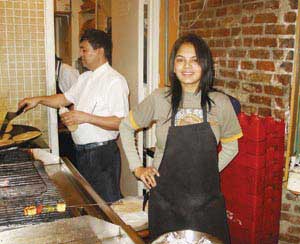

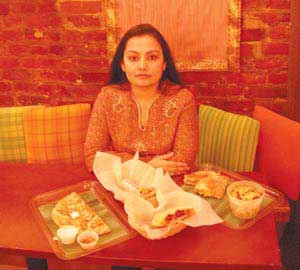
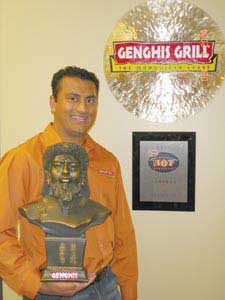
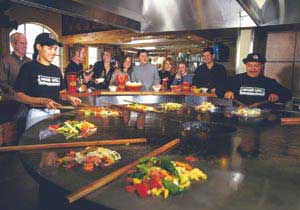
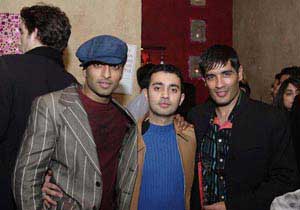
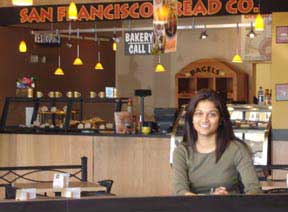
You must be logged in to post a comment Login